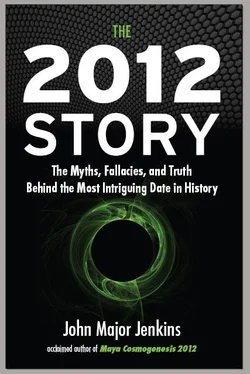His chapter on the Maya presented a standard summary and didn’t delve into the recent breakthroughs of Schele and others. Also, the galactic alignment concept remained unrecognized. He did discuss the 13-Baktun cycle end date, but following Coe’s preference reported it as occurring on December 23, 2012. One of Hancock’s beliefs is that the Maya’s calendar wisdom must have been handed down from a previous high civilization, and this was a reiteration of his main thesis, that of an earlier source-civilization that existed before the currently accepted dawn of human civilization some 6,000 years ago in the Middle East. This view doesn’t jibe too well with what we know about the independent development of civilization in Mesoamerica.
The situation that Hancock presupposes, however, of transoceanic contact between the Maya and Asia, Europe, and the Middle East, is complicated and needs to be examined carefully. In my view, the native genius of the ancient Maya was more than enough to create the Long Count and formulate profound astronomical insights. It’s extremely unlikely that the specific details of these traditions were passed down from an ancient ur-culture. The Long Count and the 260-day tzolkin are unique cultural and scientific achievements that have no parallel in other parts of the world, past or present. However, more generally we may observe that the nondual orientation of Maya cosmovision, perceiving all domains of nature as being inextricably interwoven, belongs to an archaic kind of consciousness that has been increasingly eclipsed by modernity and scientific rationalism. So in this light certain elements of Maya civilization may resemble those found in Egypt not because of physical contact and transmission but because both cultures drew from the same type of philosophical and cosmological outlook. More to the point, both looked to the heavens for a celestial prototype, and this idea was explored in Hancock’s subsequent volume, Heaven’s Mirror (1997), a beautiful book containing many photographs by his wife Santhia.
Hancock went on to explore sunken ruins off the coasts of India, Japan, and elsewhere, finding more evidence to help identify a prehistoric civilization, and published Underworld in 2004. His next book, Supernatural, was an unexpected turn for those who were followers of Hancock’s work. In it, he explored the visions induced by the South American jungle vine, ayahuasca , relating observations garnered from his own experiences taking the hallucinogenic brew. This latest offering exemplifies his continuing effort to challenge establishment limits and push back the fringes of knowledge.
The Mayan Prophecies also came out in 1995. As it promised to “decode the secret of the 2012 end date,” I was faced with the possibility that the authors, Cotterell and Gilbert, had also discovered the galactic alignment as the key to 2012. Gilbert was coauthor, with Robert Bauval, of The Orion Mystery , a book hailed as a breakthrough in decoding the astronomical alignment embedded in the Great Pyramids of Egypt. I’d read that book with great interest. The alignments involved the precession of the equinoxes, as did my discoveries among the Maya, but there was no mention of the galactic alignment in the Egyptian material. It was a simple step to notice the possibility of the alignment, but it was a very new idea. At that time (1994), it was an obscure and relatively unknown fact of precession. 24
The Mayan Prophecies proved to be a very problematic book that was riddled with basic errors and contradictions. Obsolete sources for Maya scholarship were used, and recent breakthroughs in Maya scholarship were neglected. The thesis didn’t involve precession. Instead, it turned out that Gilbert largely served as a presenter of Cotterell’s research on sunspot cycles. Using three statistical variables in solar phenomena, Cotterell claimed to be able to accurately model long-term sunspot cycle extremes, ranging between 3,300 and 3,700 years. The book presented one extreme as having occurred in 627 AD, with another one following in 2012. Clearly, there was a fundamental problem with the theory, as the interval between those two dates was nowhere near 3,300 or 3,700 years. 25
The book did not attempt to show how sunspots and solar flare cycles may have been conceived by the Maya or were encoded into their books or traditions or inscriptions. The question of how the ancient Maya who created the Long Count might have discovered the sunspot cycle extremes and calculated one far off into the future also remained unposed. A fallacy of numerical coincidence permeates the book’s premise. The laws of physics dictate that astronomical cycles often exhibit harmonic relations with one another. The Maya number 260 is a kind of key number—a common denominator, if you will—that the Maya used as a framework in their astronomical almanacs for predicting planetary cycles as well as eclipses. The sun’s dark spots orbit in a twenty-six-day period. This does not mean the Maya were aware of the sun’s dark spot periodicity.
It turned out that Gilbert, for his part, had his own ideas on 2012 to present. This confusing subplot involved the cycles of Venus. Utilizing nineteenth-century ideas proposed by Ernst Förstemann that postulated the beginning of the Long Count as “the birth of Venus,” Gilbert looked at astronomy software and noted that, in 3114 BC, Venus was west of the sun, technically in the morning star position. However, in checking the facts I noticed that Venus was not in its first appearance as morning star, which would have been the critical event, nor was it even waxing to its morning star maximum. It was, in fact, in a retrograde fall toward superior conjunction, a phase of its cycle that was meaningless as a base for the Long Count.
Later in the book, Gilbert reiterated “the birth of Venus” to explain the end date, noting that “Venus sinks below the western horizon as the Pleiades rise over the eastern horizon… as the sun sets, Orion rises, perhaps signifying the start of a new precessional cycle.” 26This summary was supposed to reveal the revolutionary breakthrough promised by the book, but it came across as a contrived attempt to link the end date with Orion, the subject of Bauval’s research. Oddly, the Orion connection to the Long Count was readily available in Schele’s research, which was not, however, mentioned in the book.
I interviewed Gilbert by phone in late 1995 and learned that his investigation of Maya traditions had begun about eight months prior to the writing deadline. He had embarked on a fact-finding trip to Mexico and had made some interesting contacts among the people of Mexico—notably José Díaz Bolio. His summary of British explorers in Mexico and Central America was interesting, if a bit ethnocentric. My observation here is not as flippant as it might sound, as Gilbert championed the old idea that Quetzalcoatl, who according to one apocryphal tale brought civilization to the heathens in Mexico long ago, was a bearded white guy from across the sea. Gilbert argued he might have been Saint Patrick, a fifth-century monk from Ireland.
During the book’s writing Cotterell had managed to pull off a promo stunt with newspaper coverage that claimed he had “decoded the Maya hieroglyphs.” This claim related not to his sunspot theory but to his fun and games with Maya art. He realized you could take drawings of pictographs from, say, Pakal’s lid at Palenque, cut them in half, edge them up to their mirror image, and generate faces and alien-looking heads. Surely, these were the faces of the secret aliens behind the Maya culture, the “supergods,” as he called them in one of his subsequent books. This is what I call a “cool stoner idea”—it appeals to a vast network of conspiracy-minded and gullible consumers. The Mayan Prophecies had all the bells and whistles in place and it sold well. Cotterell went on to produce a series of books capitalizing on his funny and entertaining art manipulations, which, however, he presented in complete seriousness.
Читать дальше












